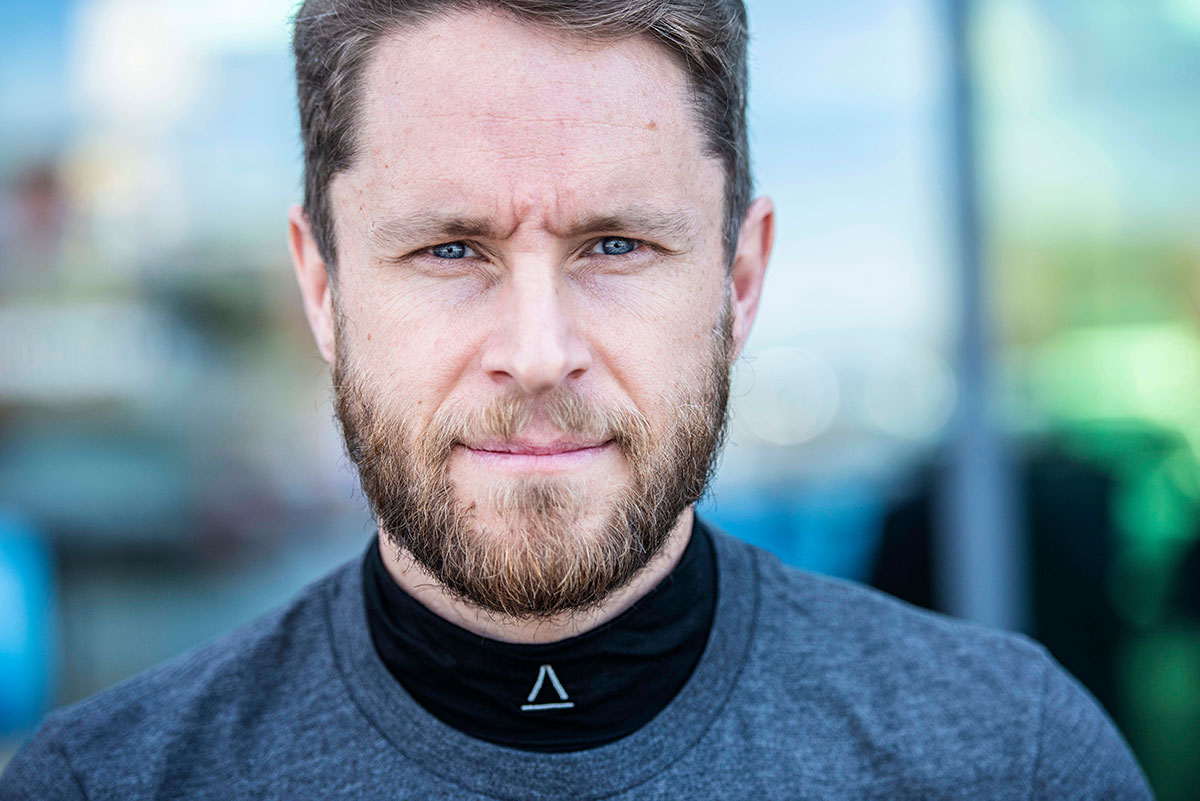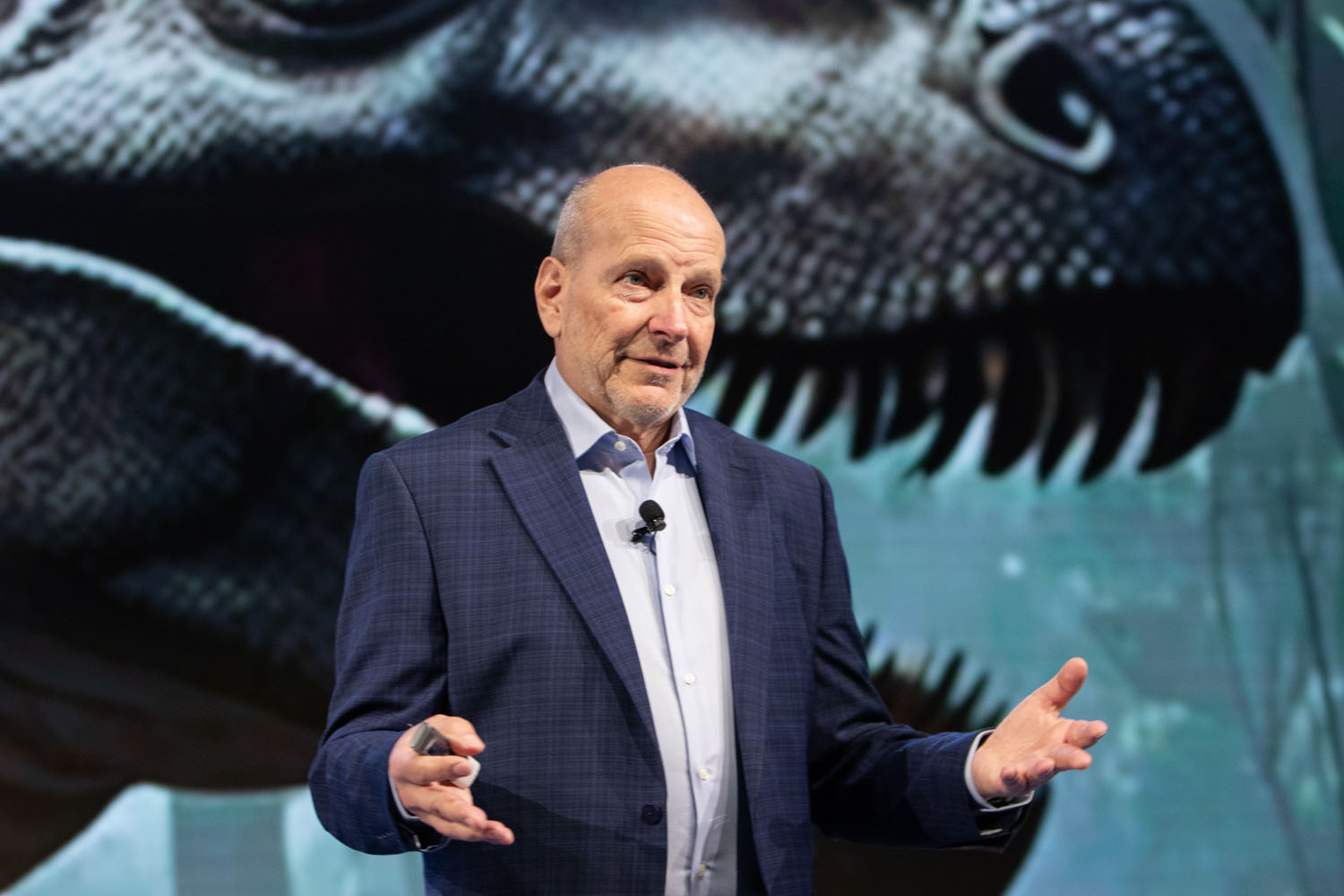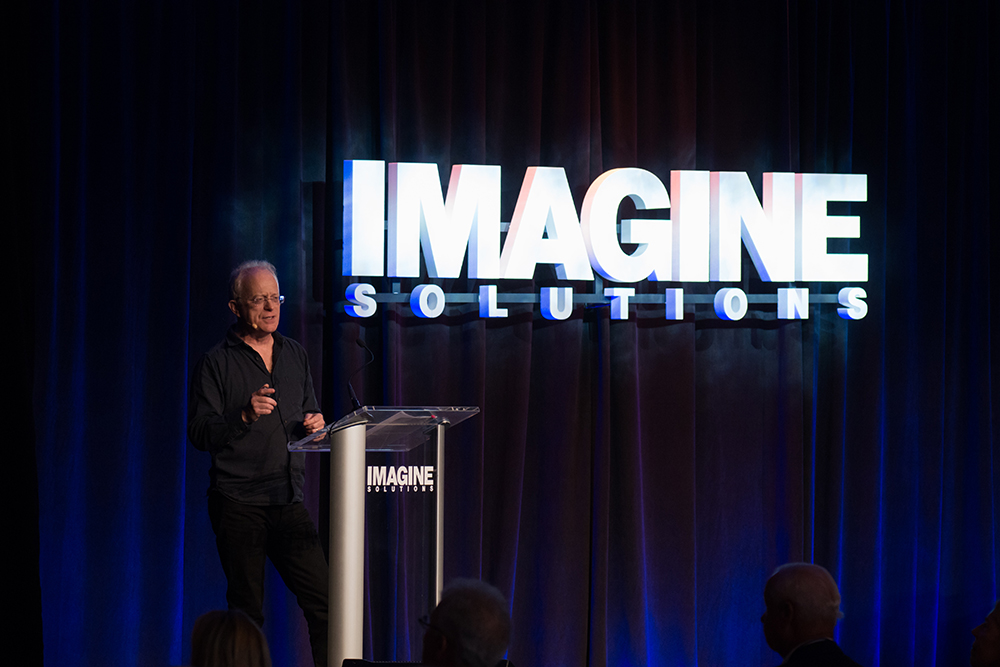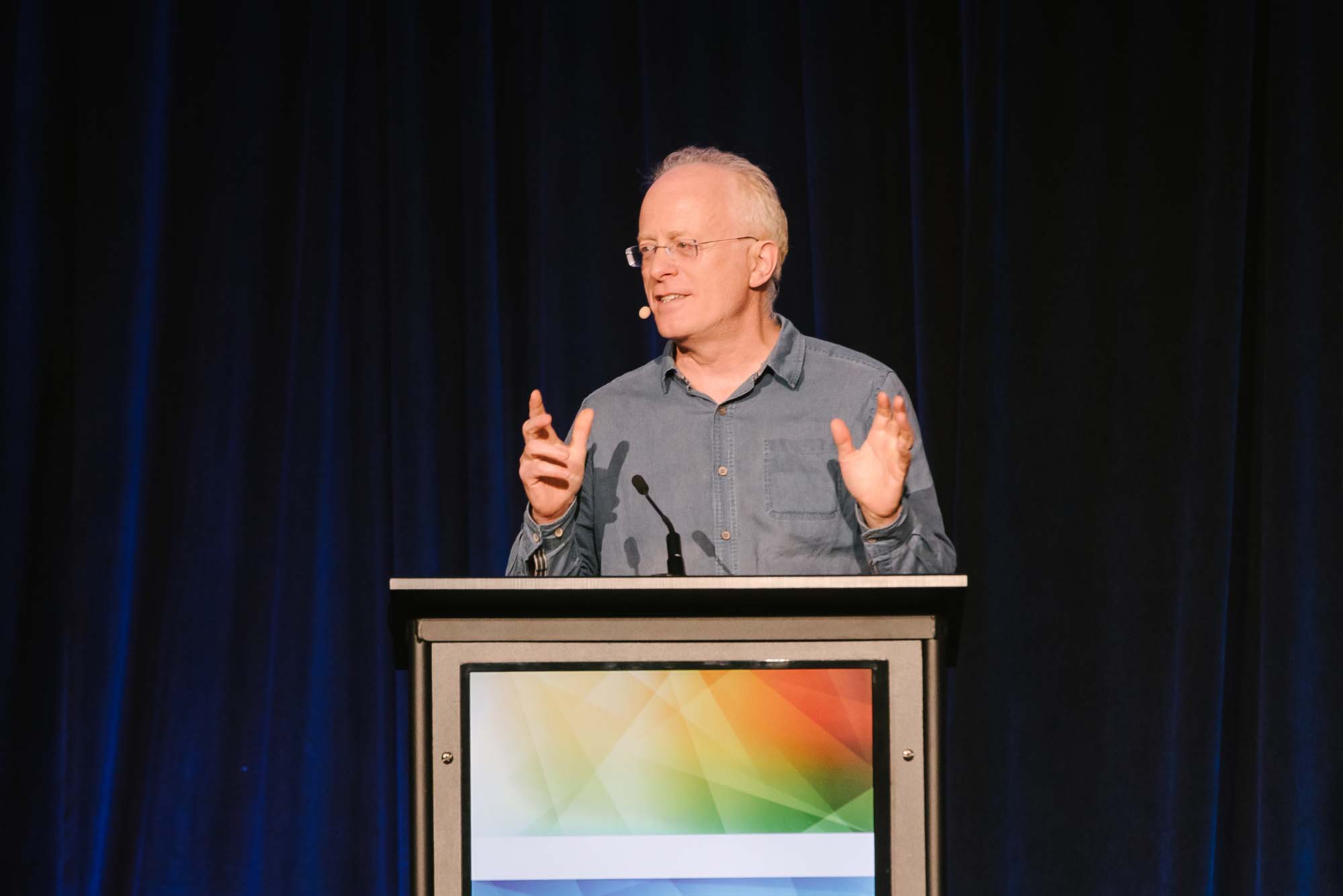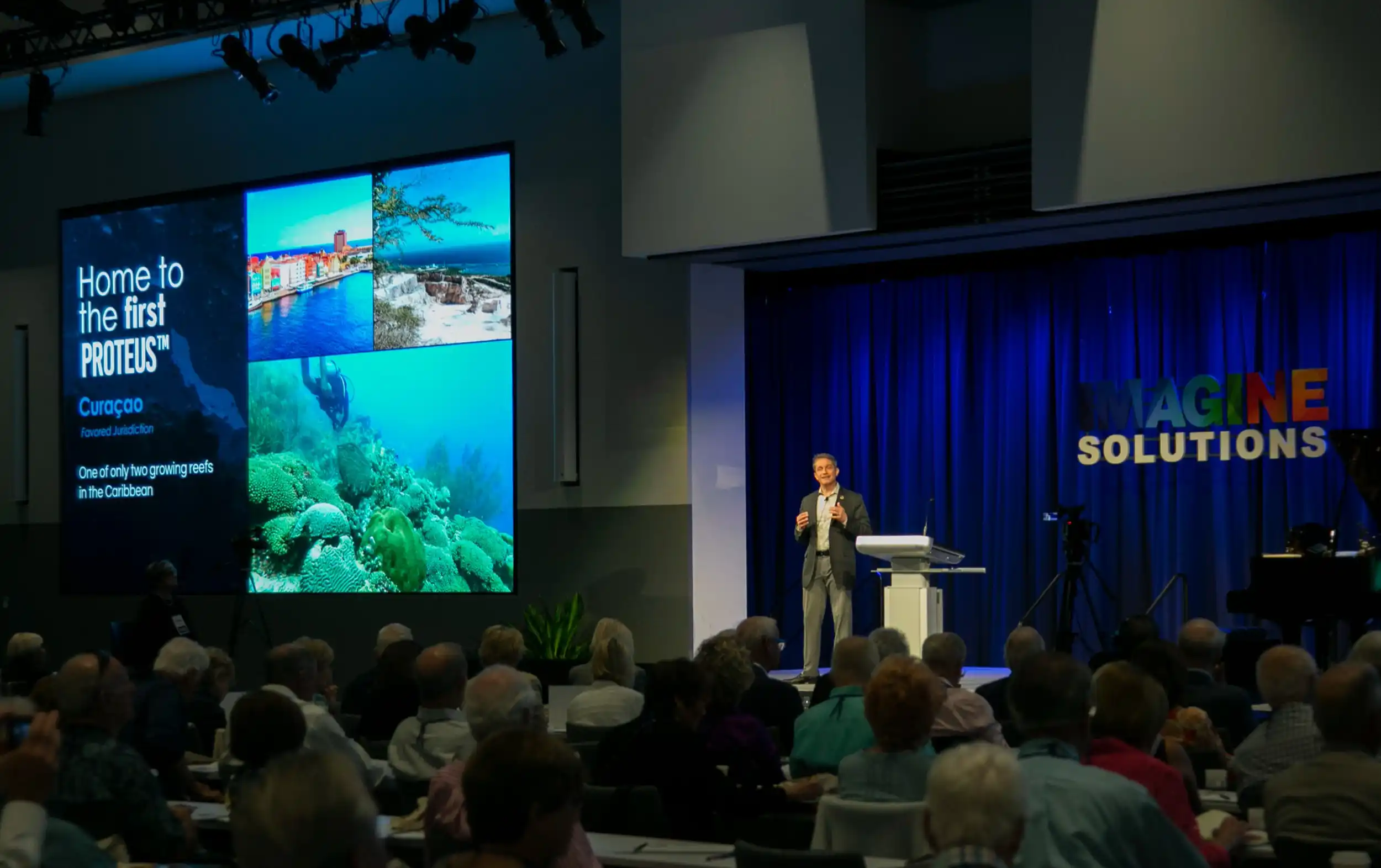Pioneering Human Flight
Follow Richard Browning’s two year journey of pioneering a new era of human flight. He is not afraid to share the failures along the way that has brought him to the point he is at now. He has flown across 30 countries and excited the Imagine Solutions Conference attendees with one of his magical demonstrations!
00.00
Richard browning is a British inventor he's an entrepreneur and the inventor of a jetpack that uses several miniature jet engines to achieve vertical flight in November of last year he set the world record for such self powered flight at more than 85 miles an hour you will see him do it at about 5 of 1 today outside there again remember your remember your earplugs for this and when he does that think about what he is wearing he is wearing literally a jet engine with kerosene fuel he is the bomb Richard come on out thank you welcome thank you fantastic thanks very much I'll slightly dispute the bomb bit but thank you for that anyway right so flight it's a subject that I think has inspired people kind of forever since we looked up at the birds
01.00
and it certainly has inspired me from an early age when I was flying little model gliders with my father back in the British countryside and I think it left a lasting impression despite the fact that for the last most of the last 16 years I was actually an oil trader with BP in the city of London I never lost the passion for the whole creative process of having a an idea especially a slightly unusual one and seeing just how far you can progress that down the journey of proving it or not and that's the story I'm going to share with you today so it's all very well thinking about little model aircraft and things but actually why not in the era of computer systems and stuff why not try and employ the human mind and body as much as you can that was really the starting point and the vision so why not try and use the brain from a balance point of view you know without thinking about it all of us actually do a very good job of balancing by walking around and from a strength point of view I used to train with this guy when I used to be in the British ROM readers reserve over alongside my day job and that taught me a lot about how actually if you just
02.00
train yourself to do something even quite out of the ordinary it's amazing how the human body and mind can adapt for it I was talking to one of one of you in the audience last night Mike I think it was who just cycle across America as an interesting challenge so there you go you know you don't wake up every morning and just decide you can do that it shows what you can do if you train and persevere into a particular direction so inspired by that I thought you know for no reason other than the pure joy of the challenge alongside that day job let's try and reimagine human flight now I'm not mad enough to think I could flap my way to that solution so I did realize I needed a form of propulsion and you need that being obviously as light and as energy dense as you can get and also being as safe as possible as well not the bomb bits I'm gonna keep coming back to that I think worried too much about the demo later so the ground zero moment for us was around February 2016 and it involved getting one of these little micro gas turbines they weigh about five pounds and put out 50 pounds of thrust it's an amazing little creation very loud but I needed to try and dismiss most of the assumptions that actually most of my
03.01
family that were from the world of Aeronautics would have easily hit me where which is that that gyroscopic moment is going to be impossible to manage it's gonna tear your arm off everything's gonna burn to the ground and you'll be dead within seconds so you know what I I sort of analyzed it all thought you know what I think that's all rubbish but there's only one way of testing this and that's getting your hands dirty so this was February 2016 so this is writing that this is a febrile 2016 this is a little dead engine on my arm and actually realizing it's very benign yes it's loud but it's just this spongy push a bit like a fire hose from from a newtonian point of view it should be it's just blowing air out of it it's just like throwing water out of a firehose at 80 miles an hour but this is air coming out at about a thousand it really wasn't actually too bad so having done that experiment with my mop bucket in that Lane in the countryside I decided to upgrade so now I'm bouncing around 100 kilos of thrust and finding it actually not too bad unless you point
04.01
them sideways in which case it's actually quite hard to stay standing up and now you can see a sort of theme here it's not gonna take a codebreaker to realise what's coming next so I've now got four that was quite a moment really because you realize you're not coming down too quickly it's quite satisfying to know that I didn't have enough power on paper to keep going up so it was it was a nice learning experience we then started to look at the legs so what about if you start putting some of that thrust on the legs after all your legs are designed to take your weight just keep turning that jet engine noise down so here it was a bit of an experiment to use a tether as well because I thought it's getting a bit tiresome falling on this concrete farmyard so let's use a tether the problem was it created effectively a v vector you're now balancing all limbs and this invisible vector that when you move to one side pulls you around so didn't really work this is an example of something that also didn't work this is now enough
05.01
power to get off the ground and stay up there but it was just too unwieldy so we stayed with the model of leg engine please turn that down more it's driving me mad I've heard about everybody else down good stuff thank you so now I've got an engine on each leg and one on each arm it's still got enough to fly but I'm giving myself moments in the air to try and learn this balance sadly without the tether which didn't work and you'll see I was rather pleased with myself at the end of this because this little exercise didn't actually end up in falling over which was a large part of what this journey was about so after months of playing around you know learning from failure this really was learning from failure we were getting there this is now 2 on each arm on one on each leg and again that momentary learning process a real challenge was when your brain realizes you're off the ground you tend to bend your knees and start pedaling and trying to find the ground again you see my leg kicking up that was a major problem because obviously that starts to rotate you but
06.00
some eight months after starting we managed to do this which is arguably the biggest kind of breakthrough moment still fighting my right leg there you go there's no wire or tether that's actually flying with six little jet engines so from there really it's been about refining it today we'll be event 130 countries and this is a little sort of snapshot of some of those events and you can tweak the music up a little bit if you like [Music] so you might notice that rather than having an engine on each leg now they actually ended up progressing to my posterior and then coalescing into one large engine because we realized that it's still a principle of three thrust vectors but that rear engine with a bit more power could lift even more fuel and also its vaporization system works except ibly well vertical but rather
07.01
than the little arm engines do not like starting vertical so that's but you know it's been an amazing journey around the world so from a commercial point of view rather than this just being a you could say a flight of fancy this is actually a money-making business three years in there's an unusual VC story I don't have to I don't have time to go through involving the Draper's in San Francisco and a check written on a banknote in a car park but I other than that this has been a really quite money-making exercise that's fueling its own journey so we do client flight training and this little clip here is an example of one of our clients we had a helicopter pilot lady last week who learned in about 20 minutes over spread over a couple of days but you see he's on a safety tether but all of that flying is him and you could see him kind of vectoring a little bit wildly but you could see all of that stability is what he's learned and when people then qualify if you like we then you know happily commissioned their own suit that's actually looking quite old that one now the entire suit is 3d printed which we'll come to in a minute from a military point of view because of my past with the British Royal Marines it's been too much of a you know temptation really to go and
08.00
play with them it is like what you would ask a 10 year old child to go and do as their pastime and we've done things like this so this was an exercise with the British Royal Navy actually it's gonna play here we go in fact next week I'm back in the UK doing a big naval exercise with the wrong Marines so there was no real game plan we just had to play around I told the p2000 patrol craft to try and lose me which was a little daunting because it felt like a big piece of Gracie but it was as far as my brain concerned not really moving as you'll see from this clip when I fly back and I went to go and bother the little media boat we had there as well by landing on the front of it all of that flight control the best way I can describe it is it's like a bicycle in that if you try to read a book about a bicycle the process of learning it doesn't make any sense it's something you feel and then you never think about it again I'm not consciously thinking about anything other than I know I'll go and land on the bridge for fun and then we didn't
09.00
even take the railings down we didn't even protect the thermoplastic deck and we didn't even move that boy out the way and you see you just slot down and land and I've got seven other pilots now in my team that could do that this I just threw this in I cut it short those this ended up doing quite a lot of a lot of views on LinkedIn of all things I don't know how many people in the room I've seen it already it didn't really ten million views on LinkedIn when I Eve was part of the Queen Elizabeth aircraft carrier visit to Washington a few months back and the British Embassy said I know go and go out and meet all the VIPs coming to view the vessel so I spent the day basically fathering all of these Admirals and senior politicians which is great fun and a good outing to my Barry when it's over water and you're not going to quickly then you know probably less dangerous than the cycle commuting I used to do in London for ten years anyway I'm gonna flip forward so from a standpoint of view I've got a 13 year older and an 11 year old and there's one really good way of getting their
10.00
generation to stop looking at iPads for five minutes and that's land a thousand horsepower jet suit in the school and the first question and again I'm going to cut this short unfortunately but the first question we always get asked is why don't you build an Ironman sea well this is the greatest way to go and to go and onto that question and I'll talk rudely over Adam Adams a good friend I met him in 2017 and he had this idea let's 3d print a titanium Iron Man suit using the original CAD files from the Ironman one film which he had to beg from the original director it's all printed in titanium and the day after this they spent the day shooting it with all sorts of different caliber weapons without and I taught him to fly but it was quite a challenge flying that because it was so heavy and you couldn't actually see out of the eyes really either but there we go flying and I'm antsy kids kind of love that no real reason at all just a bit of fun so I mentioned about the suit having progressed we hugely embrace 3d printing I heard Daniel mentioning that as well you could do a whole talk on
11.01
this but it's an amazing technology to create prototypes especially when you're not doing a hundred thousand of something we changed our mind every single design iteration so it's just great within 10 hours or so then out pops out of that powder something that looks like it's fallen off a alien spacecraft and it's a beautifully crafted 3-dimensional aluminium structure and those are the arm tubes for instance so it's an amazing it's amazing system now you know we have not backed off on the R&D of this our main focus is as I'll come to a race series training clients and also our military work and aside from doing events as well but also from a technical point of view for those of you may remember the harrier aircraft in fact I think the US Marine Corps still use Harriers we Bend as years ago unfortunately and obviously it's kind of successor in some ways the f-35 both of those aircraft in a strange way are not entirely dissimilar to the process by which we do the first part of our flying which is you vector you're throwing air downwards you lift off the ground but what are those aircraft do
12.01
next they start to transition by pushing that air backwards and then propelling themselves forward and generating lift in a far more sensible way using wings so this is what personally fascinates me from a technical point of view it's this future but it meant we went back to our origins which was not being afraid to learn from doing often ludicrous things as long as the key rule was that you weren't gonna go and hurt yourself if it went wrong and you might dispute that fact when you see this this was testing a very crude wing it's a way of creating her own wind tunnel by just driving backwards at 40 miles an hour along an airfield anyway the culmination of that was and there's an entire talk on the wing development but the culmination recently has indeed been that latest Guinness World Record clip which I'll play now so there's me in the middle I took off backwards just to watch two of my colleagues we just thought it'd be fun to have them join me although the guy on the Left went very low looking at me and nearly went into a wave in a minute you'll see I'm kind of a bit low for the wave so here I'm wearing a wingsuit inspired ram-air leg
13.00
wing you kind of elegantly spread your legs and the air pocket scoop the air it inflates into a wing and lifts your legs so now the rear-engine is propelling you the arms are still really vectored thrust but it certainly that's 85 miles an hour so that certainly allows you to tick along pretty well and then the fun bit is transitioning back again you actually have to turn the power back up flair go back into VTOL mode and then go back and you can land you know palm your hands stuff again it's been a fascinating journey and as I say I'm not going to do it justice really with the time we've got today from a commercial point of view and really because it's just ridiculous fun where we're really going is building a race series so it's not many events I've been able to stand here and say actually our next actual race event is in Bermuda on the 21st of March that's all we're crashing towards that date it's going to be a massive event any of you might happen to be I'm Emilio very welcome to come watch it it's going to be a showcase of what we can do technically and what our pilots can do and this this is a pretty basic little show real showing some of the play here we go showing some of the idea
14.02
this is treat this as and as a sort of some insight into some of what you're going to see and we've got all the suits are different coloured now we've got all sorts of different pilots with loads of different obstacles but think like Red Bull Air racing around pylons you do it over water because then if you get a fairly just fall in the water and you know you imagine the visceral kind of impact you'll see hopefully if it works as it should do so afternoon you imagine a whole bunch of people racing around like that now I'm aware the time is ticking away usually what we do is sort of celebrate there we're going to have this enormous race event and it's all gonna be great and that's going to be the future where we go and that's going to fuel even more Rd I'm gonna I'm gonna flick this forward in the interest of time now I mentioned about because I'm kind of passionate about this innovation even when I was running a trading book for VP is all about not being afraid to take risk as long as that risk when it manifests is recoverable otherwise you can't get back up as I'm sure all of you are familiar from your your professional lives if you
15.02
can't get back up again you can't keep innovating so for certain audiences we share the fails outtakes which is always you know welcome to human nature or is the bit that people enjoy the most so in the limit of time we've got I'll share with you all the little outtakes of what it really means to learn from failure be a couple of these are fuel issues that was just an ng didn't start up in sync in sync so you get kind of pushed to one side that was me that was pilot error I was I didn't realize I can't run at 20 miles an hour that was somebody got scared of a flag that was a compressor stall effort technically might have enthusiasts in the room this is why we fly fast and crazy over water so when that happens you just there's a water triggered lifejacket the entire suit has also got neutral buoyancy in it so even if the lifejacket that you can see the lifejacket even if that happened to have a problem you're still not going to sink which is a nice thought that was in the
16.00
Maldives they contaminated my fuel with fabric conditioner that was a disappointment that was one of my team not banking as you bank a jet suit you need to sort of nudge the power up as you go because you're asking the thrust to keep you in the air and change your momentum as well in those two examples they fail to do that this is our race series clip which I cut short and you can see one of my colleagues messed it up in fact actually two of my colleagues messed it up at the same time we at first and this is what happens when you try and do a superhero launch slightly too early we just didn't have enough power when he when he launched that that one looks terrible doesn't it that was a that was an unfortunate air in the fuel system issue when we were messing around so I don't want to leave all of that as the final thought and I'm aware I'm running over time here you've seen we're on a pretty hopefully you agree remarkable journey Bermuda is going to be that like I say almost a celebration showcase of what we're about and it should be kind of all over social
17.00
media where we've got a bunch of awesome brands involved in it if anybody wants to kind of get involved either from a watching point of view or supporting point of view then there's some of my details up there but I hope you enjoy the demonstration later and thank you very much



